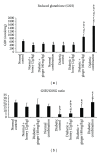Effect of the combination of gelam honey and ginger on oxidative stress and metabolic profile in streptozotocin-induced diabetic Sprague-Dawley rats
- PMID: 24822178
- PMCID: PMC4009231
- DOI: 10.1155/2014/160695
Effect of the combination of gelam honey and ginger on oxidative stress and metabolic profile in streptozotocin-induced diabetic Sprague-Dawley rats
Abstract
Diabetic complications occur as a result of increased reactive oxygen species (ROS) due to long term hyperglycaemia. Honey and ginger have been shown to exhibit antioxidant activity which can scavenge ROS. The main aim of this study was to evaluate the antioxidant and antidiabetic effects of gelam honey, ginger, and their combination. Sprague-Dawley rats were divided into 2 major groups which consisted of diabetic and nondiabetic rats. Diabetes was induced with streptozotocin intramuscularly (55 mg/kg body weight). Each group was further divided into 4 smaller groups according to the supplements administered: distilled water, honey (2 g/kg body weight), ginger (60 mg/kg body weight), and honey + ginger. Body weight and glucose levels were recorded weekly, while blood from the orbital sinus was obtained after 3 weeks of supplementation for the estimation of metabolic profile: glucose, triglyceride (TG), superoxide dismutase (SOD), catalase (CAT), glutathione peroxidase (GPx), reduced glutathione (GSH): oxidized glutathione (GSSG), and malondialdehyde (MDA). The combination of gelam honey and ginger did not show hypoglycaemic potential; however, the combination treatment reduced significantly (P < 0.05) SOD and CAT activities as well as MDA level, while GSH level and GSH/GSSG ratio were significantly elevated (P < 0.05) in STZ-induced diabetic rats compared to diabetic control rats.
Figures







Similar articles
-
Differential responses to blood pressure and oxidative stress in streptozotocin-induced diabetic Wistar-Kyoto rats and spontaneously hypertensive rats: effects of antioxidant (honey) treatment.Int J Mol Sci. 2011;12(3):1888-907. doi: 10.3390/ijms12031888. Epub 2011 Mar 16. Int J Mol Sci. 2011. PMID: 21673929 Free PMC article.
-
Neuroprotective effect of ginger on anti-oxidant enzymes in streptozotocin-induced diabetic rats.Food Chem Toxicol. 2011 Apr;49(4):893-7. doi: 10.1016/j.fct.2010.12.013. Epub 2010 Dec 22. Food Chem Toxicol. 2011. PMID: 21184796
-
Comparison of antioxidant effects of honey, glibenclamide, metformin, and their combinations in the kidneys of streptozotocin-induced diabetic rats.Int J Mol Sci. 2011 Jan 21;12(1):829-43. doi: 10.3390/ijms12010829. Int J Mol Sci. 2011. PMID: 21340016 Free PMC article.
-
Renoprotective effects of the ginger (Zingiber officinale) on Diabetic kidney disease, current knowledge and future direction: a systematic review of animal studies.BMC Complement Med Ther. 2022 Nov 11;22(1):291. doi: 10.1186/s12906-022-03768-x. BMC Complement Med Ther. 2022. PMID: 36369018 Free PMC article.
-
Honey: a novel antioxidant.Molecules. 2012 Apr 12;17(4):4400-23. doi: 10.3390/molecules17044400. Molecules. 2012. PMID: 22499188 Free PMC article. Review.
Cited by
-
Review on role of honey in disease prevention and treatment through modulation of biological activities.Open Life Sci. 2025 Mar 7;20(1):20251069. doi: 10.1515/biol-2025-1069. eCollection 2025. Open Life Sci. 2025. PMID: 40059876 Free PMC article. Review.
-
Treatment with a combination of ginger, L-citrulline, muira puama and Paullinia cupana can reverse the progression of corporal smooth muscle loss, fibrosis and veno-occlusive dysfunction in the aging rat.Andrology (Los Angel). 2015 Jun;4(1):132. doi: 10.4172/2167-0250.1000132. Epub 2015 May 25. Andrology (Los Angel). 2015. PMID: 26405615 Free PMC article.
-
Natural antioxidants in the treatment and prevention of diabetic nephropathy; a potential approach that warrants clinical trials.Redox Rep. 2017 May;22(3):99-118. doi: 10.1080/13510002.2017.1297885. Epub 2017 Mar 9. Redox Rep. 2017. PMID: 28276289 Free PMC article. Review.
-
Physicochemical and Medicinal Properties of Tualang, Gelam and Kelulut Honeys: A Comprehensive Review.Nutrients. 2021 Jan 10;13(1):197. doi: 10.3390/nu13010197. Nutrients. 2021. PMID: 33435215 Free PMC article. Review.
-
Beneficial Effects of Poplar Buds on Hyperglycemia, Dyslipidemia, Oxidative Stress, and Inflammation in Streptozotocin-Induced Type-2 Diabetes.J Immunol Res. 2018 Sep 18;2018:7245956. doi: 10.1155/2018/7245956. eCollection 2018. J Immunol Res. 2018. PMID: 30320140 Free PMC article.
References
-
- Wild S, Roglic G, Green A, Sicree R, King H. Global Prevalence of Diabetes: estimates for the year 2000 and projections for 2030. Diabetes Care. 2004;27(5):1047–1053. - PubMed
-
- Mafauzy BM. Diabetes mellitus in Malaysia. Medical Journal of Malaysia. 2006;61(4):397–398. - PubMed
-
- Letchuman GR, Wan Nazaimoon WM, Wan Mohamad WB, et al. Prevalence of diabetes in the Malaysian National Health Morbidity Survey III 2006. The Medical Journal of Malaysia. 2010;65(3):180–186. - PubMed
-
- National Health and Morbidity Survey. Fact Sheet, 2011.
-
- Diagnosis and Classification of Diabetes Mellitus. American Diabetes Association. Diabetes Care. 2004;(supplement 1)(27) - PubMed
Publication types
MeSH terms
Substances
LinkOut - more resources
Full Text Sources
Other Literature Sources
Miscellaneous

